NANBEI INSTRUMENT LIMITED |
|
3-9 KW Automatic Electric Steam Generator with Ce Certificate
First, the structure is brief
The steam generator is a single-drum type electric heating steam generator. The heating tube is arranged in the drum. After the improvement, the external water level electrode is controlled. After the external heat preservation material is used for heat preservation, the outer shell of the steel plate is used to cover the outer casing. Neat and beautiful. Users can buy it and connect it to the power and water source. The steam generator is equipped with a chain control device such as reliable water level control and pressure control. The heating pipe is arranged in the lower part of the furnace body, the steam generator can completely absorb the electric energy, the steam generator is environmentally friendly and energy-saving, and the structure is compact and reasonable. According to the definition of not applicable boiler in TSG G0001-2012 "Boiler Safety Technical Supervision Regulations" 1.3(1), the design of steam steam generator with normal water level water volume less than 30L is not subject to the provisions of the "Measures for the Supervision and Administration of Boiler and Pressure Vessel Manufacturing". Product safety performance is subject to the scope of supervision and inspection, so local supervision and inspection can be eliminated.
Second, the performance characteristics.
This type of steam generator has the following advantages:
1. Reasonable design structure can be beneficial to installation, operation and energy saving.
2. The shell is made of high quality steel with high strength and corrosion resistance.
3. the use of high-pressure vortex pump, short water supply, durable.
4. The heating time is short, and steam can be continuously generated.
5. compact structure, simple, less material consumption.
6. After loading the factory to the use site, you only need to install pipes, instruments, valves and other accessories to run.
7. installation and movement is convenient, only the customer can provide a reasonable steam generator position.
8. can supply steam to open water, but also can be used for heating.
Third, the application area:
Clothing washing and ironing industry: dry cleaning machine, dryer, washing machine, dewatering machine, ironing machine, iron, and other equipment;
Packaging machinery industry: labeling machine, labeling machine supporting use Biochemical industry: fermenter, reaction kettle, sandwich pot, mixer, emulsifier and other equipment supporting use;
Food machinery industry: supporting equipment for tofu machine, steamer, sterilization tank, packaging machine, coating equipment, sealing machine, etc.
Other industries: (oil field, automobile) steam cleaning industry, (hotel, dormitory, school, mixing station) hot water supply, (bridge, railway) concrete maintenance, (leisure beauty club) sauna bath, heat exchange equipment.
Fourth, the factory accessory
1. Steam generator main unit: steam generator body and base.
2. valves, instruments (see factory supporting list)
3.Technical documents: steam generator general drawing, electrical control drawing, installation and operation manual, one delivery list, one product quality certificate and one warranty card. When receiving technical documents, check if the products and materials are not suitable.
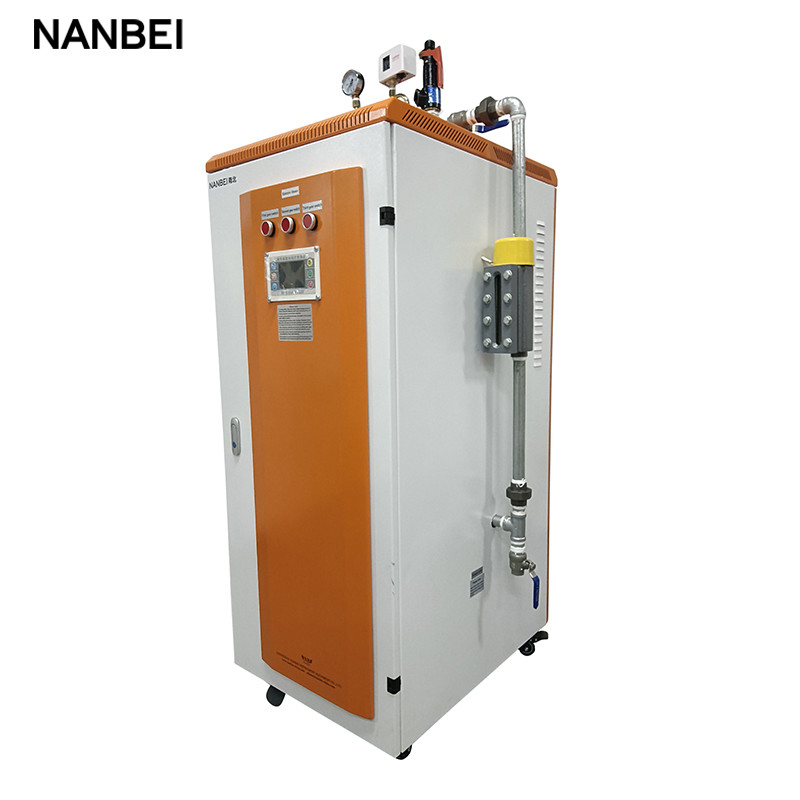
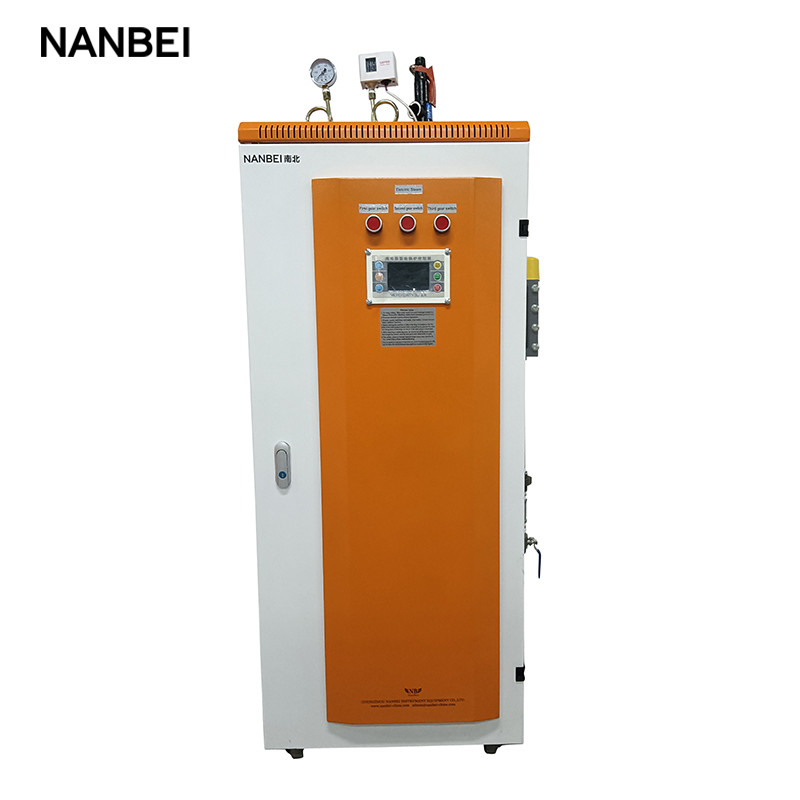
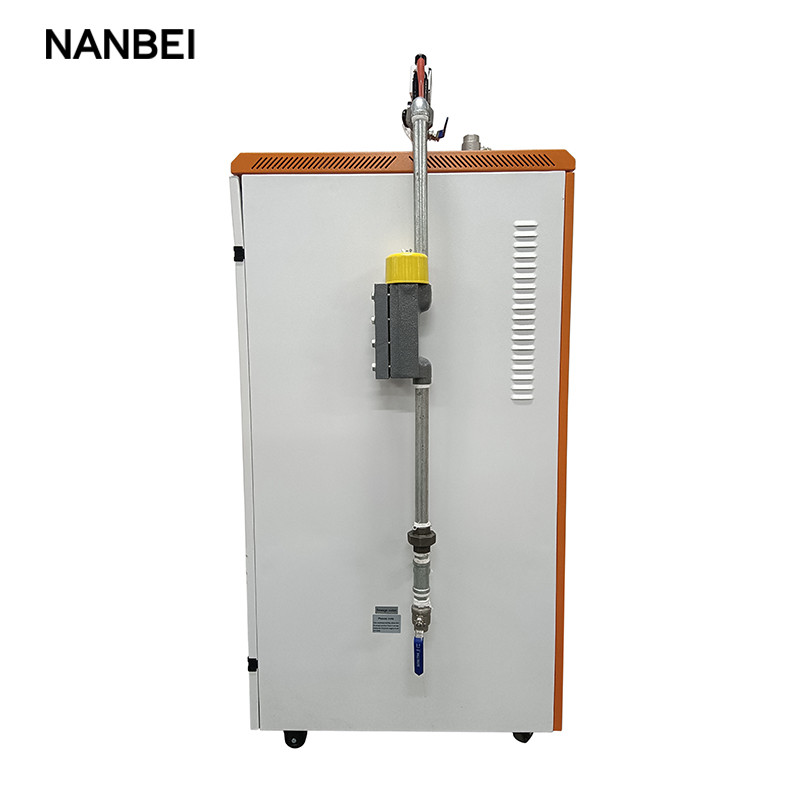
First, the function of each main part of the steam generator
1. Steam generator body: It is the pressure component of the steam generator. The pressure it can withstand is detailed on the factory nameplate. The electric heater is located at the top of the steam generator.
2. Heating tube: The electric heating tube is a heating device of the steam generator. It converts the water into steam in a predetermined time by thermal energy conversion. Since the heating portion of the heating tube is completely immersed in water, the thermal efficiency is particularly high.
3. Control box: The controller is located on the steam generator circuit board. The control panel is on the right side of the steam generator. It is the heart of the steam generator. It has the following functions: automatic water inlet, automatic heating, automatic protection, low water level alarm. , over pressure protection, leakage protection.
4. Water pump: The water pump is a steam generator water supply device. It can automatically replenish water when the steam generator is short of water or water. There are two check valves behind the water pump, mainly to control the steam generator water return and steam generation. The main reason for the hot water return is that the check valve is out of order, and the check valve should be replaced in time. Otherwise, the boiling water will damage the water pump seal and cause the water pump to leak.
5. pressure controller: is a pressure signal, converted to electrical switch signal electromechanical conversion device, its function is to output the switch signal under different pressure conditions, the factory has adjusted the pressure to the appropriate pressure at the factory.
6. Water level electrode: It is an important part of steam generator water level control. It uses water and steam conductivity to achieve automatic water level control.
7. Safety valve: It is the safety protection device of steam generator. When the steam generator is turned on, the set pressure will not stop for various reasons. When the pressure is exceeded, the safety valve will automatically open and drain the pressure to make the steam generator. The pressure is reduced to achieve the purpose of protecting the safe operation of the steam generator. In order to prevent the valve disc and valve seat of the safety valve from sticking, the safety valve lifting handle should be pulled regularly for the steam exhaust test. The air pressure should be raised once for 2~4 weeks to verify the role of the safety valve.
8. Drainage valve: installed at the bottom of the steam generator, it can completely remove the dirt in the steam generator, and the sewage should not exceed 0.1MPa.
Second, the main technical parameters table (attached table)
Schedule I
| Model | NB-3KW | NB-6KW | NB-9KW |
| Rated electric power | 3KW | 6KW | 9KW |
| Rated voltage | 220V | 380V | 380V |
| Pump power | 0.35KW | 0.35KW | 0.35KW |
| Power wiring section standard | 4mm2 | 4mm2 | 6mm2 |
| Main steam valve caliber | DN15 | DN15 | DN15 |
| Safety valve caliber | DN15 | DN15 | DN15 |
| Inlet diameter | DN15 | DN15 | DN15 |
| Sewage caliber | DN15 | DN15 | DN15 |
Schedule 2
| Model | NB-18KW | NB-24KW | NB-36KW |
| Rated electric power | 18KW | 24KW | 36W |
| Rated voltage | 380V | 380V | 380V |
| Pump power | 0.35KW | 0.35KW | 0.35KW |
| Power wiring section standard | 6mm2 | 10mm2 | 10mm2 |
| Main steam valve caliber | DN15 | DN15 | DN15 |
| Safety valve caliber | DN15 | DN15 | DN15 |
| Inlet diameter | DN15 | DN15 | DN15 |
| Sewage caliber | DN15 | DN15 | DN15 |
Schedule 2
| Model | NB-48KW | NB-72KW | NB-96KW |
| Rated electric power | 48KW | 72KW | 96W |
| Rated voltage | 380V | 480V | 380V |
| Pump power | 0.35KW | 0.35KW | 0.35KW |
| Power wiring section standard | 25mm2 | 25mm2 | 25mm2 |
| Main steam valve caliber | DN15 | DN15 | DN15 |
| Safety valve caliber | DN15 | DN15 | DN15 |
| Inlet diameter | DN15 | DN15 | DN15 |
| Sewage caliber | DN15 | DN15 | DN15 |

Third, the main function of the steam generator control panel:
1. Switch button: When the steam generator is in an emergency, press this button, all the operation of the steam generator will stop; when it is necessary to restart, just press the button and the steam generator can resume operation.
2. Operation switch: refers to the switch that stops heating and restores heating in the electric heating system.
3. Segment switch: high and low gears indicate that the heating is divided into two sections. That is, the size file is heated. This switch allows the user to arbitrarily determine the heating power as needed.
4. Buzzer: The short beep of the buzzer indicates the low water level of the steam generator; the long sound indicates that the water level is abnormal.
Steam generator and water softener installation diagram
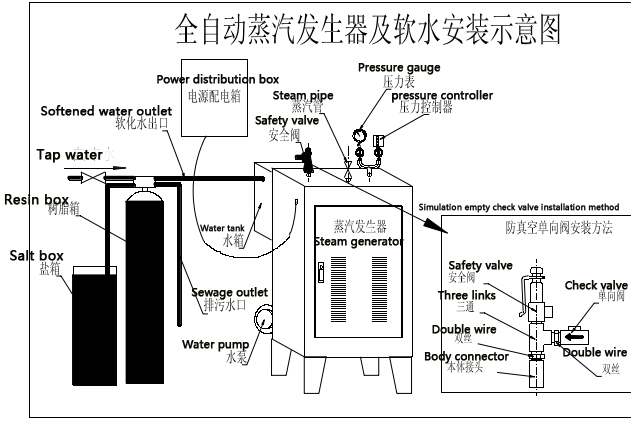
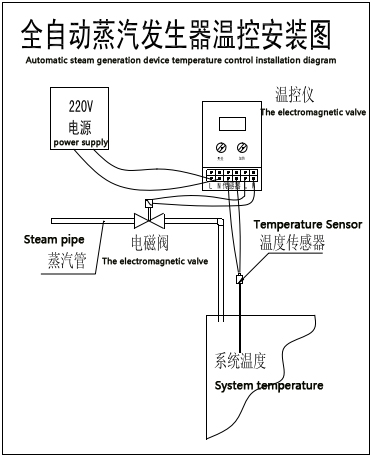
Electrical control installation diagram
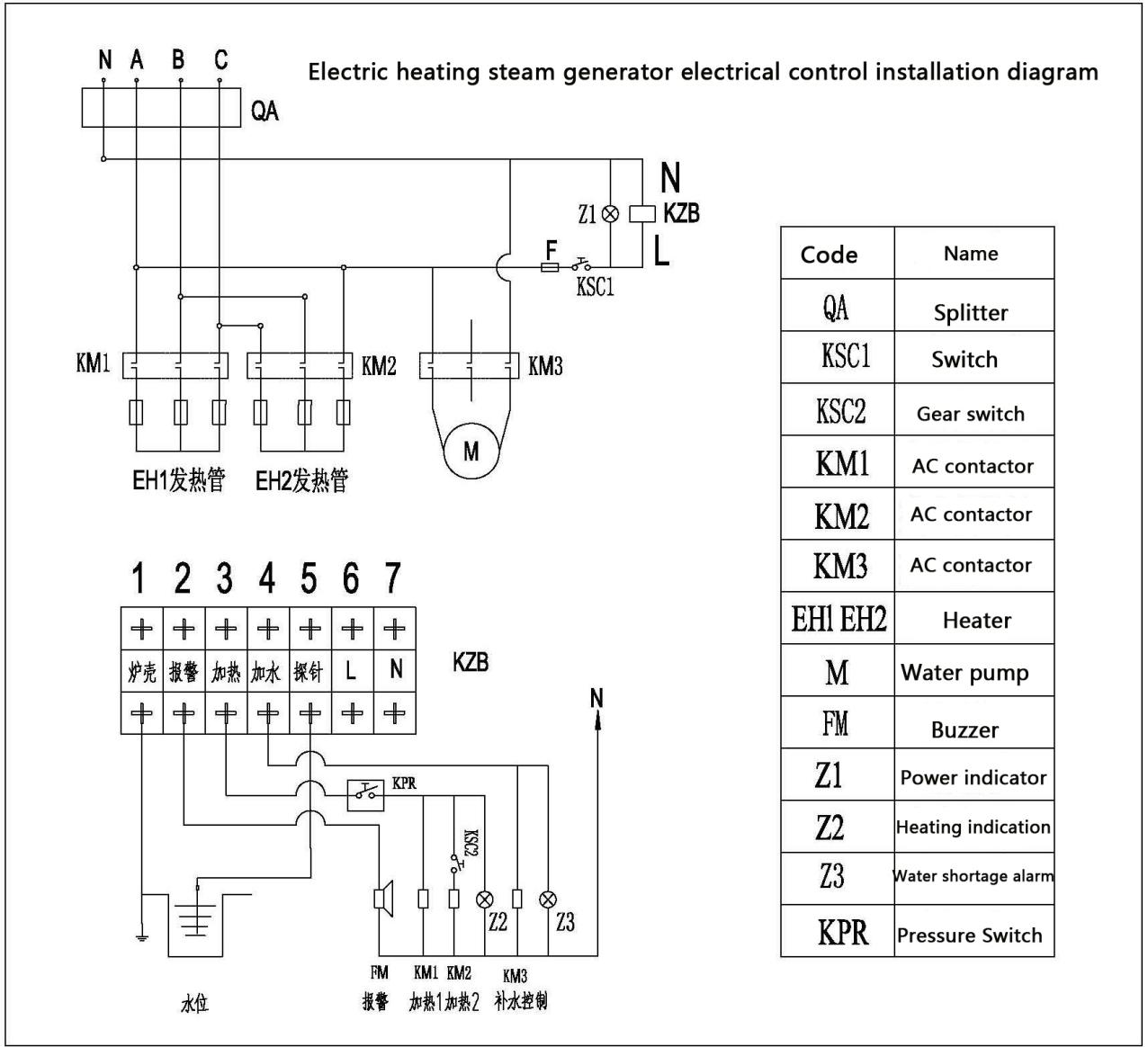
Section 3 Commissioning of Electric Heating Steam Generator
Operating procedure: After the steam generator and water softener are installed, you can follow the procedure:
Description:
1. Before the product leaves the factory, the factory has comprehensively debugged the key parts of the steam generator's heating pipe, control box, safety valve, pressure controller, sewage, water pump and so on.
2. Under normal circumstances, as long as the water and electricity are all connected as shown in the figure, the button of the control box can be opened to enter the fully automatic operation without the need for the user to debug again.
3. The water treatment should be referred to the water treatment section of this instruction manual. Press ON/OFF button, the power work light is on, turn on the power, add water light to add water, the water pump starts, open the water supply valve, add soft water to the water tank, the power indicator light is on, the normal water level light is on, the heating reaches the highest pressure, and the lowest pressure is set. Reheat. Press ON/OFF button, the heating light is on, the water supply lamp is on, the heating lamp is off, the heating is stopped, the heating lamp is on, the heating starts, and the power working light is off.
Section 4 How the water softener works
First, why should we use a water softener?
1. The hot water steam generator will generate scale. The scale is brittle material. After thick, the crack is prone to occur. The water in the steam generator pipe passes through the crack and suddenly contacts the hot pipe wall, and a large amount of water vapor is formed by rapid vaporization. When it is too late to distribute, the steam generator will explode.
2. The thermal conductivity of scale is very poor, reducing the thermal efficiency of the steam generator and wasting fuel. The scale in the water pipe is reduced, and the flow cross-sectional area is reduced. In severe cases, the pipe will be completely blocked and the normal water cycle will be destroyed. The scale is attached to the heated surface, especially in the tube, which is difficult to remove, and the heated surface is damaged, shortening the service life of the steam generator.
Second, the characteristics of water:
Water is a very good amphoteric solvent because its solubility is so good that we can't get pure water directly in nature. We found that the dissolved minerals and content in the water are different depending on the source of the water. The dissolved ions in natural water are mainly minerals dissolved when water flows through the rock formation. The hardness of groundwater is generally higher, while the hardness of surface water is lower. We are used to determining the type of water based on the amount of dissolved minerals in the water. We often classify the water according to the total hardness of the water (ie the sum of calcium and magnesium ions): Table 1 is classified by hardness and salt content by hardness (carbonic acid) Calcium mg/l count) Name according to salt content Mg/l Extreme hard water>450 High salt>1000 Hard water 300-450 High salt water 500-1000 Medium hard water 150-300 Medium salt water 200-500 Soft water 50-150 Low salt water 100 -200 Extremely soft water <50 Very low salt water <50
Third, Why does water produce scale when heated?
The solubility of minerals dissolved in water generally increases with increasing temperature, but individual minerals decrease with increasing temperature, as these minerals change after the temperature rises, for example: calcium Magnesium salts:
Calcium and magnesium ions in water are the main factors of scaling. In nature, calcium and magnesium ions are present in the form of calcium bicarbonate and magnesium bicarbonate. The solubility of these two minerals in water is very high. The solubility of calcium bicarbonate in water in 100 ml is about 16.6 g, and the calcium bicarbonate is in temperature. In the high process, decomposition occurs and becomes calcium carbonate. The solubility of calcium carbonate in water is only 1.3 mg (18 ° C). When the calcium carbonate crystals precipitated from the water are densely packed, they form what we see in the kettle. White hard scale.
Fourth, the harm of scale to the steam generator The thermal conductivity of calcium carbonate scale is very small, which will not only increase the energy consumption of the steam generator, but also threaten the safety of the steam generator. The thermal conductivity of scale and steel is given in Table 2: Table 2 Thermal conductivity of scale and steel Comparison Table name Thermal conductivity Koal/mHc Name Koal/mHc Thermal conductivity Copper 320-360 Sulfuric acid scale 0.2-2 Carbon steel 30 -45 silicate scale 0.07-0.2 cast steel 25-50 carbonate scale (amorphous) 0.2-1 oily scale 0.1 carbonate scale (crystal) 0.5-5 The thermal conductivity of scale is only a few thousandth of copper material, Two hundredths of steel. After the steam generator is fouled, if we still want to reach the temperature of the furnace water when there is no scale, it is necessary to increase the temperature of the heated surface. For example: a 10 ton steam generator with a wall temperature of 280 ° C. When the silicate scale is 1 mm, the same furnace water temperature is reached, and the wall temperature is increased to 680 ° C. At this time, the strength of the furnace steel plate is reduced. In severe cases, it will cause an explosion, and the temperature rise will cause the material stress to be destroyed and the energy consumption to increase.
Five. Purpose and method of water treatment:
The purpose of water treatment in the steam generator system is very clear. We must eliminate the harm caused by scale to the steam generator, save energy consumption and prolong the service life of the steam generator and obtain High running integrity. The main factor of scaling is the dissolved calcium and magnesium ions in the water. The method of removing calcium and magnesium ions outside the furnace is to use demineralized water as the feed water of the steam generator. The softening method employed is the ionic resin method.
Six, the installation and commissioning of the water softener
1. Location selection
A. The shorter the distance from the soft water device to the drain, the better.
B. If there is a possibility that additional water treatment equipment may be needed, sufficient room should be reserved.
C. Because the salt must be replenished regularly to the control valve, the distance between the salt box and the control valve should not be too far.
D. The soft water device should not be close to the hot water source, because it is too close to the hot water source, which will damage the soft water control valve. So a 3 meter long pipe is a reasonable distance to prevent this possibility from happening. (When a negative pressure is found, a positive way to prevent hot water from flowing from the heat source to the control valve is to install a check valve from the soft water pipe from the regulator. If a check valve is installed, the softener should be installed A suitable overheating and overpressure safety valve must also be in accordance with local regulations.
E. Do not install the soft water unit in a place that will allow it or its connectors (including drain pipes) to withstand room temperature below 0 °C or above 49 °C.
F. Do not place the soft water device close to the acid or acid mist.
2. Connection method of entrance and exit:
The connection method of the entrance and exit is relatively simple. Just refer to the system diagram, install the 0.6MPa pressure gauge and manual valve in the inlet pipe, and connect the solenoid valve, flow meter, manual valve and sampling valve in the outlet pipe.
3. Connection of the drain line:
A. The ideal safe position is that the water control valve should be at the upper part of the discharge port and not more than 6.1 m from the drain. Connect the unit to the drain of the controller with a 1.3 cm (1/2 inch) inner diameter plastic tube (Figure 2).
B. If the unit is placed at a distance of more than 6.1 m from the drain to 12.2 m from the main pipe, use a 1.9 cm (3/4 inch) pipe.
C. Also purchase the adapter to lining down to the drain line connection. If the unit is installed in a place where the drainage line must be raised, if the total length of the pipe does not exceed 4.6 m and the water pressure at the water regulator is not less than 0.277 MPa, the drainage line can be increased to 1.8 m at most. An additional 61 cm is added for every 0.07 MPa increase in water pressure.
Warning 1: If the unit is equipped with a transmitter, the maximum lift is 1.2 meters regardless of the water pressure.
A. When the drainage line is lifted but discharged into a discharge below the plane of the control valve, an 18 cm Pontoon conduit shall be formed at the distal end of the drainage line so that the bottom of the conduit is at the same height as the drainage connection. . This will also replace a suitable siphon well.
B. When a drainage line is discharged into an elevated sewage water line, a dirty well must be used. WARNING: Do not connect the drain line to a drain, sewer or gas seal. There must be an air gap between the drain line and the waste water to prevent the sewage from being siphoned back into the water processor. Note: Standard commercial usage is described here. However, local regulations may require some modifications to these recommendations.
III. Instruction manual
The steam generator use unit shall designate the special (part-time) personnel to be responsible for the daily maintenance and safety management of the steam generator. The furnace workers must go through the basic knowledge, safety technical knowledge and professional training of operational skills, and master the operational skills before they can be employed.
First, the cooking stove
1. The new steam generator should be used before the use of the boiler. The main purpose is to remove the impurities and grease inside the steam generator. When the boiler is used, the steam generator needs to add appropriate drugs to make the boiler water alkaline and remove the grease. Etc.
2. the boiler can use soda ash (Na2CO3) or trisodium phosphate (Na3PO4.12H2O) and other drugs, the amount of which is calculated by the volume of steam generator per cubic meter, the former is 5 kg and the latter is 3 kg.
3. The above-mentioned drugs used before cooking should be formulated into a uniform solution with a concentration of 20%. Solid drugs should not be directly added to the steam generator.
1) Close all valves and inspection holes, open the upper main steam valve, pour the prepared drug solution into the steam generator tube once, open the safety valve, let the air in the drum discharge outward, and open the inlet valve to the pot. Flowing water, the inlet water temperature does not exceed 40 ° C, after the steam generator system is filled with water, close the water supply valve, check whether the steam generator main unit, water supply pipe, valves, etc. leak.
2) the steam generator pressure rises to 0.2Mpa and maintains for 2 hours, then stops burning and the pressure gradually reaches zero, the water temperature is lower than 70 °C, open the drain valve, and release all the water in the pot.
3) After the steam generator is cooled, flush the internal parts of the drum with clean water and open the inspection hole for inspection. If it is found that there is still oil, follow the above method, and then cook the furnace until there is no oil in the steam generator.
Second, heating
1. The steam generator and piping system must be thoroughly inspected before heating, and then the treated water is injected into the steam generator. The drain valve must be closed before the water is introduced, and the air release valve is opened to allow the air in the steam generator to be discharged. When the water level of the steam generator rises to the water level to control the normal water level, the feed water pump is automatically turned off. After the water level is stable, observe whether the water level has decreased.
2. Turn on the heating switch to allow the heating group to heat normally.
3. Pay attention to the water level at any time after heating, because the water level will rise after heating. If the water level exceeds the maximum water level, proper drainage can be performed to reduce the boiler water.
4. When steam is generated in the open vent valve, the vent valve should be closed, and the pressure gauge curve and water level gauge should be flushed. When the steam pressure reaches 0.2Mpa, check whether the inspection hole leaks. If there is leakage, it should be Tighten the bolts and check that the drain valve is tight. When the pressure rises to the working pressure, check if the safety valve sprays water.
Third, the supply of steam
When the steam pressure in the steam generator is close to the working pressure, the water level should not exceed the normal water level, and the heating is stable when steam is supplied. When steam is supplied, the total steam valve should be slightly opened to allow the trace steam to be warmed. At the same time, the drain valve on the pipeline is opened to vent the condensate. The warming time is determined according to the length, diameter and steam temperature of the pipeline. Not less than 10 minutes, attention should be paid to the expansion of the pipeline and the condition of the bracket when the heating pipe is concerned. If abnormal conditions are found, the heating pipe should be stopped immediately, and the faults and defects should be eliminated. After the pipe is hot and the condensed water on the pipeline is reduced, it can be fully opened. The total steam valve should be opened slowly and should not be opened too much. Generally, it should be controlled between 1.5-2 turns, and the rated output can be achieved under normal combustion conditions.
Fourth, normal operation
When the steam generator is running, the on-duty personnel carefully implement the various systems related to the safe operation of the steam generator, make the duty record and the shift record, and may not leave the post without authorization.
The steam generator is required to operate normally. The steam generator has normal water level, stable steam pressure, keeps the steam generator room clean and tidy, strengthens the monitoring of parts and instruments to ensure safety and reliability, and prevents accidents. The furnace workers should regularly sum up experience. Continuously improve the level of operation.
The water level of the steam generator shall not be higher than the highest water level and lower than the lowest water level. At least one water level gauge should be flushed per shift to keep the water gauge glass tube clean and ensure that the water level is clear, correct and reliable. In the event of damage, the furnace should be temporarily shut down immediately until the water level gauge returns to normal.
Always pay attention to the change of steam pressure, keep the pressure in the pot as stable as possible, and do not make the steam pressure exceed the maximum allowable working pressure. The pressure gauge bend should be flushed once per shift.
In order to prevent the steam generator from being damaged due to water slag and scale, the quality of the boiler water must be ensured, and the alkalinity should not exceed 18 meq/liter. When the range is exceeded, the boiler water should be drained.
(1) When the test conditions are not complete, the general user may regularly discharge the pollutants according to the specific conditions, such as once a day or once a shift.
(2) sewage should be carried out at low load and high water level. Pay attention to the water level in the steam generator when discharging the sewage. It is better to reduce the steam generator water level by 25-50mm each time. The sewage discharge time should not be carried out continuously for a long time, so as not to affect the water circulation.
(3) After the sewage is closed, close the drain valve and quickly test whether the pipeline is cooled by hand. If it is not cooled, the drain valve must leak.
After the steam generator is filled with water, turn the power switch to the (ON) position, and heat up and turn on the indicator when the electric heating unit is turned on. The steam generator enters normal heating. The steam generator room should be kept clean and no other debris should be stacked in the steam generator room. Pay attention to the lighting inside the house. The water level gauge and pressure gauge should be well illuminated for easy observation. When the furnace workers hand over the shift, both parties should be thorough and serious, and at the same time record the situation and problems in the shift shift into the operation record.
Fifth, stop the furnace
If the fault occurs, the furnace should be shut down. After the power is cut off, the cause can be checked to solve the problem. In order to repair, the furnace water must be discharged to eliminate the fault.
Sixth, maintenance and repair:
1. The steam generator should be inspected once a year for the operation of the casing, valves, instruments, etc., and should be commissioned by a professional unit for repairs.
2. The steam generator should not be dry or wet-maintained for a long time. If the furnace is shut down for more than one month, the dry maintenance method should be used. The wet maintenance method should be used after the furnace is stopped for one month.
3. A hydraulic test should be carried out once a year.
Seventh, troubleshooting
1. there is work at boot, or heating is very slow, check the power supply, whether there is a lack of phase.
2. During operation, the AC contactor has a loud hum and the contactor armature has foreign matter. If the coil wiring is loose, check if the power supply voltage is too low.
3. When the user does not have relevant professional knowledge, he should contact the manufacturer immediately.
Eighth, steam generator common faults and troubleshooting
Fault phenomenon
| cause of issue
| Method of exclusion
|
Cannot be enabled after power up
| 1, poor power supply wiring 2, the fuse is damaged 3, contactor does not fit | 1, check the power supply and wiring 2, replace the fuse core 3. Repair or replace the contactor |
| The pump does not turn | 1, the fuse is damaged 2, the contactor does not fit 3, the pump impeller is stuck 4. The pump motor is damaged and the capacitor is burnt out. | 1, replace the fuse core 2. Repair or replace the contactor 3, clean the impeller foreign body, if there is damage, replace the impeller 4, repair the motor or replace the same specification capacitor |
Pump water supply pressure is insufficient Or no water supply | 1. Pump reversal
2, there is air in the pump
3, the water channel is blocked | 1. Check the direction (the wind wheel behind the pump is rotated clockwise) Turn) and give replacement wiring 2. Unscrew the pump bleed screw plug and wait for water to overflow from the screw hole. Then tighten the screw plug 3. Clear waterway foreign bodies |
Slow or no heating
| 1, heater burning 2, the fuse burned out 3, the contactor burned out | 1, replace the heater 2, replace the contactor 3. Repair or replace the contactor |
Contactor does not work
| 1, stuck 2, the coil burned out 3, contactor damage | 1. After disconnecting the power supply, pull the contact point with a screwdriver. 2, replace the contactor 3. Repair or replace the contacts |
The contactor is not strong or Invulge | 1, the power supply voltage is too low 2, the contactor has intermittent beating 3, three-phase power supply phase difference | 1, check the power supply voltage 2, the voltage is too low to pressurize 3, check and give exclusion |
| The pump stops or does not move stop | 1, the liquid level is stuck 2, the liquid level controller is damaged 3, the contactor burned out, stuck | 1. Remove the liquid level controller to remove scale 2, replace the liquid level controller 3. Repair or replace the contactor |
| Pump pressure is not high | 1, impeller wear 2, the pump casing wear 3. There is air in the pump | 1. Adjust the clearance between the impeller and the pump casing, or replace the impeller 2, adjust the gap or change the pump 3, let go of the air |
Water level maintenance in the generator Can't live | 1. Check valve or solenoid valve leaks | 1. Replace check valve or solenoid valve leakage |
| Work pressure is too high or too low | 1, the pressure controller fails | 1. Tell or replace the equivalent pressure controller |
| Electrical circuit failure | 1, low insulation resistance, wire overheating | 1, keep dry, ask the electrician to overhaul |
Leaking water ,leaking steam
| 1. Pipe joints or valve gates are not tight 2, the seal is damaged | 1. Repair and tighten, replace the valve 2, replace the seal |
Parameter configuration table
| Serial number | Category | Unit | Value and description
| |
| 1 | Rated evaporation | t/h | 0.3 | |
| 2 | Rated steam pressure | MPa | 0.7 | |
| 3 | Saturated steam temperature | ℃ | 171 | |
| 4 | Feed water temperature | ℃ | 20 | |
| 5 | Design heat exchange area | Radiation | m2 | 1.23 |
| Convection | m2 | 3.23 | ||
| Energy saver | m2 | 2.87 | ||
| 6 | Design thermal efficiency | % | 91.2 | |
| 7 | Design fuel | --- | natural gas Light oil | |
| 8 | Design exhaust temperature | ℃ | 175 | |
| 9 | Total resistance to smoke from the chimney exit | Pa | 130 | |
| 10 | Normal water volume | L | 28.7 | |
| 11 | Main steam valve caliber | mm | 25 | |
| 12 | Water supply diamete | mm | 15 | |
| 13 | Drain valve diameter | mm | 15 | |
| 14 | Safety valve caliber | mm | 40 | |
| 15 | Energy saver inlet and outlet | mm | 15 | |
| 16 | Flue mouth diameter | mm | 159 | |
| 17 | Maximum shipping size (length * width * height) | mm | 2000x1400x2050 | |
| 18 | Maximum dimensions (length * width * height) | mm | 2000x1600x2300 | |
| 19 | Boiler transport weight | Kg | 960 | |
| 20 | Fuel consumption | natural gas | Nm3/h | 23.2 |
| Light oil | Kg/h | 19.2 | ||
| 21 | Base size (length * width) | mm | 2000x1100 | |